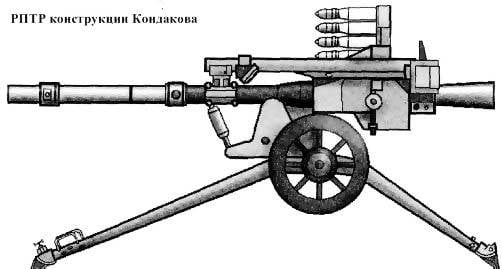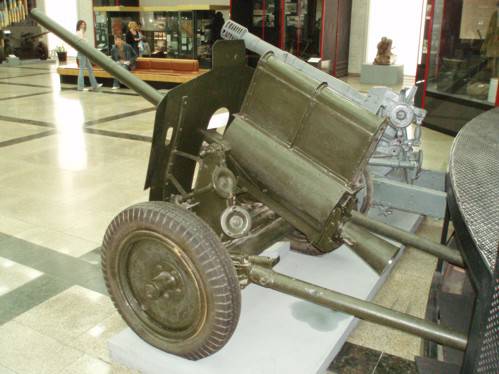37-mm automatic recoilless gun Kondakova. THE USSR. 30

Before the war, we just developed exactly beztkatki with a loaded barrel. Much has been written about the adventurer Kurchevsky, and about M.N. Kondakov information is extremely small.
Moreover, Kondakov, in contrast to Kurchevsky, was not only repressed, but remained steadfast until his death in 1954 the head of a powerful artillery design bureau (initially called the design bureau of the Academy, and then OKB-4З).
Kondakov was the first in the world to create a recoilless automatic gun. Automatic guns worked on the principle of exhaust gases. It is impossible to consider Kurchevsky’s guns as automatic, where the cartridge supply was due to the muscular strength of the shooter or the compressed air from the cylinder.
In January, 1934 Kondakov and Tolochkov proposed projects of automatic 76-mm recoilless air cannons. In AU, the project was generally approved, but the competitors were initially offered to create a reduced sample of the 45 mm and 37 mm systems, which was done in OKB AU.

The 45-mm gun was made and successfully tested. Both the 76-mm and 45-mm guns had a loaded barrel, but this ended their similarity with the Kur-Chevsky DRP. Automatic guns worked by the removal of powder gases from the barrel. Food clip-on. In the cage 6 shells. Fireproof brass sleeve. After the shot, the barrel moved forward to 450 mm, after which the spent cartridge case was extracted and the next cartridge was fed.
In 1935-1936 Kondakov created the 37-mm RPTR company rocket gun (in fact, it was a gun). A significant contribution to the design of the gun made S.E. Rashkov.
This principle of automation was applied by Kondakov in the 45 mm aviation and 37 mm anti-tank guns.
37-mm RPTP created under the scheme of a loaded trunk.
On the battlefield, the system was transported on wheels. In addition, she easily understood and transferred to human and equine packs.
Caliber mm: 37
Angle VN deg: -10 ° - + 15 °
Angle GN degree: 60 °
Barrel length with a funnel mm: 1550
Total system length, mm: 1650
The weight of the system in the combat position: 63 kg.
Practical rate of fire, rds / min: 30
Tests of the prototype RPTR were started at the end of 1936 at the NIAP. The standard 37-mm armor-piercing projectile from 37-mm PTP was taken as projectiles. 1930 g. Weight of the projectile 0,674 kg, fuse MD-5. At NIAP, the RPTR showed the same accuracy of shooting as the 37-mm PTP arr. 1930
Projectile weight, kg 0,674
Charge weight, kg 0,175
Initial speed, m / s 545
Channel pressure, kg / cm2 2450
Plant number 7 received an order for a small series of X-Numx guns RPTR. However, in the mass production of the RPTR did not go because of the general prejudice against recoilless guns. Before that, there were complaints about the weight (!) And the unmasking effect of the gas jet.
But unlike Kurchevsky’s guns, Kondakov’s automatic drawbacks worked quite well. In the projects were automatic calibers 45 and 76,2 mm, which really could be used in the USSR aviation.
Alas, the mediocre designs of the adventurer Kurchevsky greatly compromised the very idea of recoilless guns. Shirokorad writes that in 1943 g, after the appearance of information about German 75mm and 105 mm recoilless guns, Stalin said about this: "They also splashed out the child along with the dirty water."
In the museum on Poklonnaya Hill, there is a very interesting instrument that I cannot identify. This is probably one of the experienced guns Kondakova gun carriage.

Continuation and addition from other sources:
According to GKO Order No. 1454 of September 17, 1943. OKB-43 developed the 76-mm Aviation Automatic Gun DRP-76. The gun fired unitary shots weighing 8,75 kg. The projectile weighing 4,6 kg had an initial speed of 530 m / s. The gun firing order was 80 shots / min. Feed tape. In the 6 tape cartridges. Factory ground tests DRP-76 was held in 1949 at the Air Force test site. Tests confirmed the relatively high design data of the gun, including good accuracy, but the Air Force refused it. OKB-43 redid it into the ship system. In 1951-1952 DRP-76 passed the tests on the boat-hunter (MO), but the Navy did not want to deal with the DRP.
Information